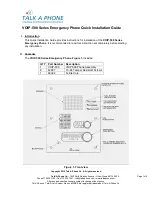
Introduction
3-3
Chapter 3 - Attendant Features and Operation
Introduction
The instructions in this chapter are based on the use of a digital display telephone.
The
Triad-S
System provides the following keys, indicators and features:
Handset and Speaker
are located at the left side of the front panel. A handset is provided to
allow confidential conversation when desired. Lifting the handset from its cradle (going
off-hook) disengages the station’s built-in speaker.
The speaker is located directly below the center portion of the handset. The station may be
operated with the handset on-hook. When this occurs, audio is transmitted to the station
user through the station’s speaker.
Flexible Buttons
access idle outside lines, provide DSS/BLF for internal stations, access
speed dial numbers and activate features. These buttons can be programmed by the
individual station user. The default flexible feature buttons are described as follows:
CALL BACK button lets you initiate a call back request to another busy station. As soon as
that station becomes idle, the station that left the call back request is automatically
signaled. A flexible button must be assigned to use this feature.
PICK-UP button lets you pickup a tone ringing intercom call, transferred, incoming
,
or
recalling outside line call to a specific unattended station by group or directed call
pickup.
DND (DO NOT DISTURB) button. On Attendant stations, this button becomes the system
Night Mode button. A flexible button must be assigned to use this feature.
LINE QUEUE button lets you queue onto an outside line when all lines in a group are busy.
Your station is placed in queue awaiting a line in the same group to become available.
Fixed Feature Buttons
function as follows:
VOLUME BAR
lets the user adjust ringer, speakerphone and handset volume.
H-T-P lets the user select the ICM Signaling Mode, handsfree tone, or privacy.
FLASH button terminates an outside call and restores dial tone without hanging up the
handset. It also transfers calls behind a PBX or Centrex within those systems.
CAMP-ON button lets you alert a busy party that an outside line is on hold and waiting for
them.
MSG (MESSAGE WAIT) button lets you initiate a message waiting indication at stations
that are busy, unattended, or in Do Not Disturb. Message Waiting Callback request left at
your station is indicated by a flashing MSG WAIT LED.
SPEED button gives you access to speed dialing, save number redial and last number
redial. This button also accesses flexible button programming.
TRANS (TRANSFER) button transfers an outside call from one station to another.
CONF (CONFERENCE) button establishes and builds conference calls.
FORWARD (FWD) button lets you forward your calls to another station.
ON/OFF button lets you make a telephone call without lifting the handset. It turns the
telephone on and off when using the speakerphone.
Содержание Starplus Triad-S
Страница 1: ...STARPLUSTM Triad S Feature Package 4 System Programming Operation...
Страница 14: ...xii Contents...
Страница 16: ...xiv Figures...
Страница 26: ...N O T E S...
Страница 192: ...2 166 Least Cost Routing Chapter 2 Features and Operation INTENTIONALLY BLANK...
Страница 304: ...N O T E S...
Страница 326: ...N O T E S...
Страница 372: ...4 48 Uniform Call Distribution Chapter 4 Call Distribution ACD UCD...
Страница 374: ...N O T E S...
Страница 388: ...A 16 ICLID Call Management Tables Chapter ICLID Caller ID...
Страница 390: ...N O T E S...
Страница 416: ...B 28 Programming LCR Tables Chapter Least Cost Routing...
Страница 418: ...N O T E S...
Страница 484: ...C 68 Programming Tables Chapter Customer Database Programming Table C 21 6 Digit Area Code Routing Table Area Code Route...
Страница 486: ...C 70 Programming Tables Chapter Customer Database Programming...
Страница 488: ...N O T E S...
Страница 504: ...D 18 Part Numbers Chapter Flash Codes and Numbering Plans...
















































